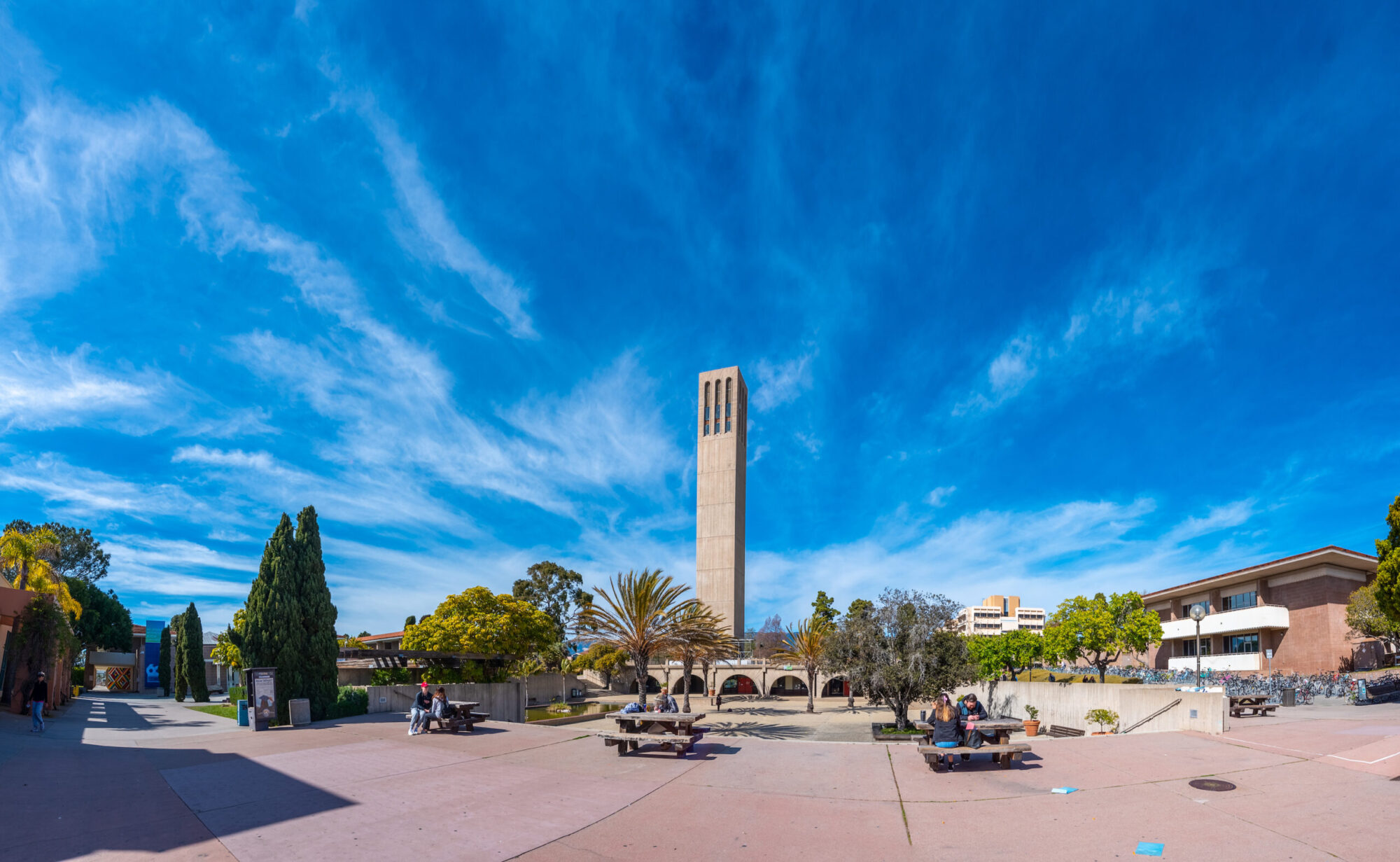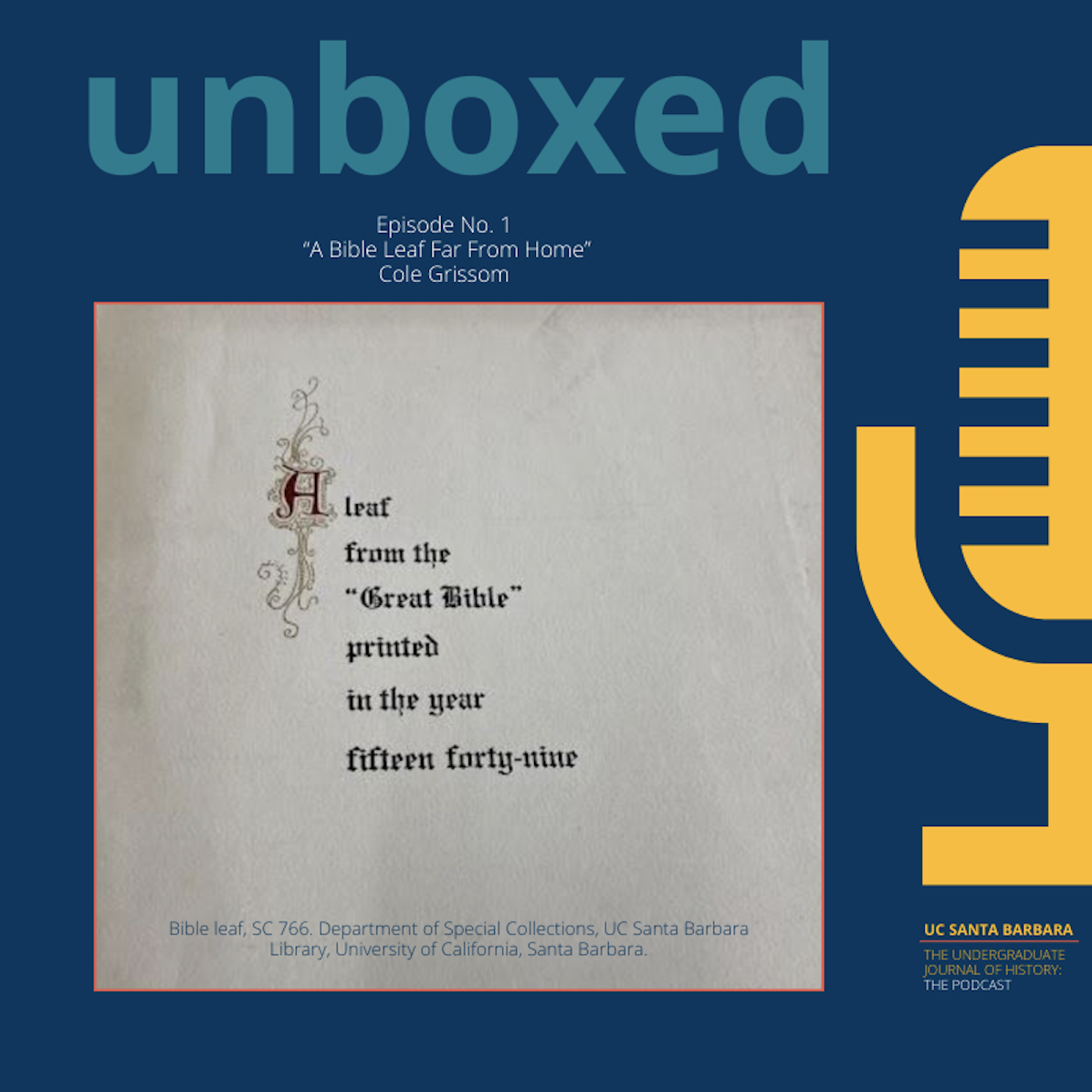Hey everyone, thanks for tuning in. This is the UCSB Undergraduate Journal of History: The Podcast. In this season, we’re sharing with you our archive stories of unboxing cool history stuff that we found in the vaults of the UCSB Library Special Research Collections.
I’m your host, Cole Grissom, a fourth-year history major specializing in late antiquity and the early Middle Ages. In today’s episode of Unboxed, we delve into the UCSB archives and special research collections to discover the interesting, novel, and sometimes even profound historical materials being stored right here at UCSB. Today, I’ll be taking a look at a Bible Leaf from 1549. For some images of today’s archival collection, follow us on Instagram @UCSBhistjournal. Ok, let’s see what this gray Hollinger box has in store for us today.
– Act 1 –
Somewhat isolated within the special collection, in reflection of the nature of the item itself, is a single leaf from the Great Bible printed in the year 1549 protected by a large paper folder. I chose this item because of my interest in antiquity and medieval Europe, times and places both of which were dominated by the Christian worldview. In order to understand the viewpoints of people who lived during these periods, it’s essential to approach them as a historian with an understanding of what many would have considered their most important text, the Bible.
While this leaf partially accomplishes that by virtue of having been written in 1549, I thought it also served as an interest interesting lens into peoples’ relationship with the Bible within the context of its resale in the United States on Christmas of 1939, only a few months after the outbreak of World War two. By understanding how the people of this time would have related to the verses within, a blueprint can be gathered for doing so further and further back into history.

Bible Leaves are two sided sheets of paper that originally belonged as part of a larger, whole Bible. While some vendors may have removed them from whole Bibles themselves, they were more often sold in the past because an extremely old Bible would be missing many pages by the time it found its way into the hands of a collector. Because of this, it’s difficult to say how many Bible leaves exist, since there could still be many ancient and medieval Bibles we don’t yet know of.
Information on the origin and sale of this specific leaf is provided through a message on its folder written by Floyd A. Allen, president of a Los Angeles company bearing his name which appears to no longer be in business. Dated Christmas 1939, the message stresses the “unchanging, powerful and eloquent” nature of the book from which the leaf was taken. One can imagine the comfort these words were meant to inspire given the invasion of Poland by Hitler’s Germany only two months prior. In an extremely violent world with an uncertain future, the ever-unchanging Bible would have been looked at by many as a beacon of stability and peace.
Allen goes on to make this even more explicit through his stressing of how the “greed, hatred and avarice”, in his words of the world provides a “need to seek from this book guidance to perpetuate our civilization, to preserve our country, to protect our homes, and hold firm in our belief in God”. While this offers some general insight into the mindset of the much more religious America of 1939 as compared to now, its specific composition during World War Two provides a more specific view into the role religion played in America during a time of war.
While the Bible doesn’t change, it is interpreted and used differently by people throughout history, and Allen’s message here is a reminder of that.
– Act 2 –

The Gospel of John, from which this leaf was taken, was in its time specifically addressed to Greeks, as revealed by its original writing in Greek and opening with a linking of Jesus with the Greek idea of a logos, or divine reason. In 1939, however, nearly 2000 years later, the same text was being used to communicate ideas of morality to 20th century Americans. The idea of somebody buying a Bible leaf today outside of dedicated collectors is rather hard to imagine. This mattered to people of the past, however, and it offers us today insight into how they thought about and processed the world around them.
Within the middle of Floyd’s message is a short aside assuring the buyer of the authenticity of the piece. It reads: “This Bible in English, that is, the old and New Testament, after the translation is appointed to be read in the churches. Imprinted in London on Fleet Street. By Edward Whitechurch, the 24th day of December, the year of Our Lord”. Since this leaf is from 1549 and the King James version wasn’t written until 1611, 60 years later, this leaf has to then belong to a page of the “Great Bible”, one of the first Bibles to ever be printed in English. While innocuous now, the fact that this Bible was printed in English was a very big deal at the time.
For over 1000 years, the Catholic Church printed bubbles exclusively in Latin rather than the vernacular of different countries. This was mostly done to preserve the meaning of the text, as translation into different languages would inevitably produce error, and by the by the time it got into Latin in the first place, they’d often already gone through Hebrew and or Greek texts before.
The fact that Latin was scantly known by the lower classes of medieval Europe, combined with the fact that Bibles of the time had to be copied by hand, meant that few were able to read or possess a Bible. The proliferation of the printing press in the 15th century changed everything, however. Through printing, the Bible was made orders of magnitude cheaper, while learning Latin was not. This combined with a broader movement against the church hierarchy by theologians such as Luther and Calvin provided the perfect opportunity for Bibles to start being printed in countries’ vernacular. This specific Great Bible was authorized by Henry VIII soon after breaking from Catholicism and founding the Church of England in 1534, making it very, very early.
– Ad –
Elena: I hope you’re enjoying this episode of Unboxed. My name’s Elena–
Troy: And I’m Troy. Both Elena and I are members of the UCSB History Club and avid listeners of UNBOXED. That’s right. Troy.
Elena: The UCSB History Club is a big supporter of the Undergraduate Journal of History and hope that listeners of Unboxed will also consider joining us at History Club events.
Troy: We sure do Elena! The History Club at UC Santa Barbara is a student run campus club that meets weekly during the academic year. We host faculty and graduate student speakers as part of our fireside chat series. We also get together to play games and study, host potlucks, and holiday themed events.
Elena: And Troy, don’t forget that sometimes we even travel to local heritage sites around Santa Barbara. So if you want to get in on the fun, follow us on Instagram @UCSBhistoryclub. We hope to see you at the history club meetings soon. Okay, now let’s get back to this episode of Unboxed. Oh, I can’t wait to hear how this one ends.
– Act 3 –
While the backstory behind this Bible being printed in English is important as a historical piece, this specific leaf of the Great Bible also offers a window into the crucial world-shattering moment in European history that was the outbreak of World War Two through the stories depicted within: the Washing of the Feet and the Last Supper. Both stories took place on the same night within biblical canon, the night of Jesus’ betrayal and handing over to the Roman authorities by the Sanhedrin to be crucified according to Orthodox interpretation.
Both stories exemplify selfless love. In the first Jesus, who Christians believe is God, humbles himself to wash his followers’ feet, including Judas, the man who would betray him. In the second Jesus, according to some denominations, gives his literal flesh and blood to unite his followers with him and give them eternal life, while other denominations view the last supper as a symbolic reminder of Jesus’ death for humanity.
The theological background is important to understand why Alan would choose these verses to counter the, in his words, “greed, hatred, and avarice of the world”, nearly two months after the beginning of World War II. Both involve selflessness, love, and service to others.
Beyond simply serving as a commentary on the war region in Europe, these verses would have served as a reminder to Americans of a potentially more peaceful world reflecting the values depicted within biblical stories. Not only would these have served as a source of comfort during an extremely destructive and uncertain time, but for some, they would have been viewed as a foundation for a blueprint for the future after the war.
– Summary –
I hope the amount of information contained within a single double-sided sheet of paper from an old, admittedly dusty Bible demonstrates the importance of the text when approaching the ancient and medieval worldview. From just a few lines of text, a dedicated historian can delve into issues of biblical translation, theological disagreements over the meaning of the text, the sorts of views sincere believers the text would have possessed, and how people throughout different times of history would have related to the stories within.
While the Bible is an object, an inanimate book, people’s interpretations of it throughout history have been extremely important in political, philosophical, and social thought, changing accordingly with the times.
If this was true for the American Henry A. Allen in December of 1939, who viewed the Washing of the Feet and the Last Supper as reminders of a moral code distinct from that of national socialism in Europe, how much truer would it have been for people centuries, if not millennia removed from us today. The first principles of worldview as contained within religious belief had serious implications for those who believed in it, and by understanding what these first principles are, historians’ understanding of historical figures that believed in them is greatly increased.
– Sneak Peek –
Thanks for listening to this episode of Unboxed. Be sure to join us next week as Hanna shares their archive story of Unboxing a comic depicting the 16th century Spanish expedition of Panfilo de Narvaez from the UCSB Library Special Research Collections. To see some images of today’s archival collection, check out our Instagram page @UCSBhistjournal and follow us on Spotify at The Undergraduate Journal of History: The Podcast.

